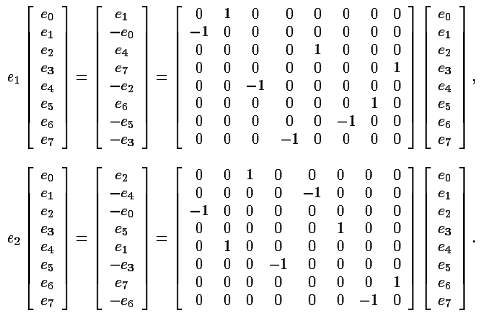
BACK | CONTENTS | NEXT | OCTONION HOME | MATHEMATICAL IDEAS IN SCIENCE |
Division Algebras, Lie Algebras, Lie Groups and Spinors

It's very easy
to associate matrices with octonion units. I've done it with e1 and
e2
above. There is a unique matrix derived in this way for each of the 8 basis
units
(including the identity). Like the imaginary octonion units themselves, the
7 matrices
associated with the imaginary octonion basis units anticommute, but unlike the
octonion units, these matrices do not close under multiplication. In fact, via
matrix
products and sums they generate all of R(8) = CL(0,6), a 64-dimensional
algebra.
However, although the product of the two matrices above may not be associated
with a single octonion unit, it is in fact associated with a more complicated
octonion
action arising out of octonion nonassociativity.
For X an arbitrary
octonion, the first matrix is associated with the action,
eL1[X] = e1X, the second matrix with the action eL2[X]
= e2X, and the product
of the second matrix times the first with the action:
eL12[X] = e1(e2X).
(Ignore the fact that the matrix product is associated with the reverse octonion
product; what's important is that the product is in fact associated with this
embedded
action involving two octonion units; we won't be using the matrices after this.)
These ideas were
developed in fairly deep detail in the
book. We'll go into them
a little quicker here.
BACK | CONTENTS | NEXT | OCTONION HOME | MATHEMATICAL IDEAS IN SCIENCE |